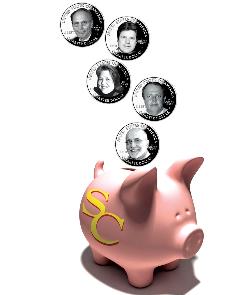Simpson’s 10 highest paid see transition in appearance of benefits

April 9, 2008
According the IRS/Form 990, the highest paid person at Simpson is President John Byrd with compensation, benefits and expenses totaling $264,831 for the 2006-2007 fiscal year. This salary includes access to a “rent-free” home and a car.
The IRS/Form 990 is a tax document which requires non-profit organizations to report the top five highest paid officers and non-officers of the organization, essentially the top 10 highest paid personnel at Simpson.
According to the Internal Revenue Service, the Form 990 is available for public inspection and, for some people, serves as the primary or sole source of information about a particular organization.
The salaries of the 10 highest paid employees not only include compensation, but benefits and expenses as well. Benefits include retirement contributions and health insurance while expenses may include an expense allowances and tuition remission.
Tuition remission is given to those who have a child or spouse who is taking courses at Simpson or other private colleges with similar agreements. It’s another incentive for those working for a private college.
Due to changes in the way the tax forms have been filled out this past year because of recommendations from an outside accounting firm, it is difficult to compare salaries to those in the past.
“The reason the accounting firm recommended the change is due to scheduled changes in how the IRS will want us to report the compensation in coming years,” Adam Voigts, assistant vice president for business services/controller, said. “The accounting firm suggested we make those changes now.”
Voigts went on to explain how the changes affect Simpson’s tax reporting.
“This change is to report compensation in the 990 so that it ties to their compensation reported to the IRS on their W-2,” Voigts said. “This is always going to be a lower amount because there are deductions that decrease the total compensation to what is reported on their W-2 for taxable income.”
The main difference in the reporting is the change from reporting gross income as compared to taxable income.
While compensation has appeared to have decreased, benefits for employees have appeared to have skyrocketed, in some cases by over 100 percent.
“In the past, amounts reported for benefits included only the portion of retirement funds that were contributed by Simpson as the matching portion,” Voigts said. “This year, in addition to the Simpson portion, the reported benefits include the amounts that employees chose to contribute out of their compensation. The employee portions of retirement fund contributions is an example of a deduction to get to taxable income.”
The total amount of compensation reported is effectively the same. The changes in reporting have simply added more to employee benefits and less to compensation.
Across the board, Simpson faculty and staff members have received a 3 percent increase in their salaries from last year. This percentage is the same as the year previous.
Simpson is working hard to keep salaries competitive for the president, staff and faculty alike.
“[The salaries] are a little bit lower than we would want them to be,” Steve Griffith, vice president and dean for academic affairs, said. “We’re trying to bring them up but it’s difficult. Once you sort of fall behind and get behind, it’s difficult to catch up but if an institution is getting a 3 percent raise or another is getting a 3.5 percent raise that catches up over time.”
Fred Hubbell, chairman of the board of trustees, echoed the need to keep salaries competitive.
“This year, we hired an outside firm to do an external analysis of schools and their presidents in Iowa and surrounding states, to find out how we compare in regards to salary and benefits,” Hubbell said. “That gave us an idea of what they’re paying and if we’re competitive.”
According to Hubbell, the firm also did extensive evaluations of President Byrd’s employment contract, but the secretary, treasurer and president of the Board of Trustees have the ultimate decision on his salary.
The Chronicle of Higher Education also keeps records of executive compensation at both private and public colleges and universities.
According to their data from the 2005-2006 school year, President Byrd is on the lower end of the spectrum for compensation than other institutions of our size. Compared to Central College, Coe College, Cornell College, Graceland University, Luther College, Upper Iowa University and Wartburg College, only Graceland University’s president receives less compensation than Simpson, with a total salary of $156,003.
Despite these numbers, President Byrd received a $21,941 raise from his salary last year, a 9.03 percent increase. Part of the reasoning of the higher percentage is the opportunity for the school to match retirement fund contributions.
“The board is very happy with what the president is doing,” Hubbell said. “We try to make modest increases in his base salary but lengthen his contract and increase the incentives.”
President Byrd’s contract will be extended to 2011, as confirmed by the board of trustees.











